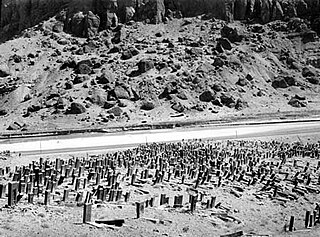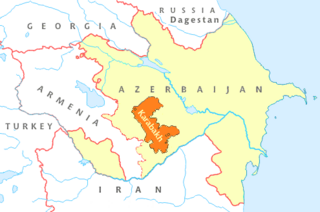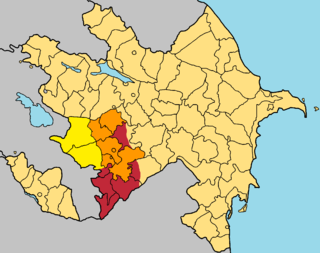Related Research Articles

Nagorno-Karabakh is a region in Azerbaijan, covering the southeastern stretch of the Lesser Caucasus mountain range. Part of the greater region of Karabakh, it spans the area between Lower Karabakh and Syunik. Its terrain mostly consists of mountains and forestland.

Artsakh, officially the Republic of Artsakh or the Republic of Nagorno-Karabakh, was a breakaway state in the South Caucasus whose territory was internationally recognised as part of Azerbaijan. Between 1991 and 2023, Artsakh controlled parts of the former Nagorno-Karabakh Autonomous Oblast of the Azerbaijani Soviet Socialist Republic, including its capital Stepanakert. It had been an enclave within Azerbaijan from the 2020 Nagorno-Karabakh war until the 2023 Azerbaijani offensive, when the Azerbaijani military took control over the remaining territory controlled by Artsakh. Its only overland access route to Armenia after the 2020 war was via the five kilometres (3.1 mi)–wide Lachin corridor, which was placed under the supervision of Russian peacekeeping forces.

The First Nagorno-Karabakh War was an ethnic and territorial conflict that took place from February 1988 to May 1994, in the enclave of Nagorno-Karabakh in southwestern Azerbaijan, between the majority ethnic Armenians of Nagorno-Karabakh backed by Armenia, and the Republic of Azerbaijan with support from Turkey. As the war progressed, Armenia and Azerbaijan, both former Soviet republics, entangled themselves in protracted, undeclared mountain warfare in the mountainous heights of Karabakh as Azerbaijan attempted to curb the secessionist movement in Nagorno-Karabakh.

The Nagorno-Karabakh conflict is an ethnic and territorial conflict between Armenia and Azerbaijan over the region of Nagorno-Karabakh, inhabited mostly by ethnic Armenians until 2023, and seven surrounding districts, inhabited mostly by Azerbaijanis until their expulsion during the 1990s. The Nagorno-Karabakh region was entirely claimed by and partially controlled by the breakaway Republic of Artsakh, but was recognized internationally as part of Azerbaijan. Azerbaijan gradually re-established control over Nagorno-Karabakh region and the seven surrounding districts.

The Republic of Artsakh was a republic with limited recognition in the South Caucasus region. The Republic of Artsakh controlled most of the territory of the former Nagorno-Karabakh Autonomous Oblast. It was recognized only by three other non-UN member states, Abkhazia, South Ossetia and Transnistria. The rest of the international community recognized Artsakh as part of Azerbaijan. In November 2012, a member of Uruguay's foreign relations committee stated that his country could recognize Nagorno-Karabakh's independence. In 2012, Armenia and Tuvalu established diplomatic relations, which led to speculation of possible recognition of Artsakh by Tuvalu. In October 2012, the Australian state of New South Wales recognized Nagorno-Karabakh. In September 2014, the Basque Parliament in Spain adopted a motion supporting Artsakh's right to self-determination and in November 2014, the Parliament of Navarre, also in Spain, issued a statement supporting Artsakh's inclusion in taking part in settlement negotiations.

Relations have always been strong between Azerbaijan and Turkey, the only two predominantly Turkic countries located west of the Caspian Sea. Former Azerbaijani president Heydar Aliyev often described the two as being "one nation, two states."

The Armenian cemetery in Julfa was a cemetery near the town of Julfa, in the Nakhchivan exclave of Azerbaijan that originally housed around 10,000 funerary monuments. The tombstones consisted mainly of thousands of khachkars—uniquely decorated cross-stones characteristic of medieval Christian Armenian art. The cemetery was still standing in the late 1990s, when the government of Azerbaijan began a systemic campaign to destroy the monuments.

United Nations Security Council resolution 822 was adopted unanimously on 30 April 1993. After expressing concern at the deterioration of relations between Armenia and Azerbaijan, and the subsequent escalation of armed hostilities and deterioration in the humanitarian situation in the region, the Council demanded the immediate cessation of hostilities and the immediate withdrawal of Armenian occupying forces in the Kalbajar district near Nagorno-Karabakh in Azerbaijan.

United Nations Security Council resolution 874, adopted unanimously on 14 October 1993, reaffirmed sovereignty and territorial integrity of the Azerbaijani Republic and of all other States in the region, called for the preservation of the ceasefire, cessation of hostilities and withdrawal of forces from recently occupied districts of the Republic of Azerbaijan, and reaffirmed resolutions 822 (1993) and 853 (1993). The Council expressed its concern at "...the conflict in and around the Nagorny Karabakh region of the Azerbaijani Republic, and of the tensions between the Republic of Armenia and the Azerbaijani Republic...", and called upon the parties to observe the ceasefire agreed with by the government of Russia and OSCE Minsk Group.
Məmər is a village in the Qubadli District of Azerbaijan. It is situated along the Vorotan river.

Stepanakert Airport or Khojaly Airport is an airport in the town of Khojaly, 10 kilometers north-east of Stepanakert, Azerbaijan. The airport, in the Nagorno-Karabakh region, had been under the control of the self-proclaimed Republic of Artsakh from 1992 to 2023. Flights ceased with the escalation of the First Nagorno-Karabakh War in 1990.

The Madrid Principles were proposed peace settlements of the Nagorno-Karabakh conflict, proposed by the OSCE Minsk Group. The OSCE Minsk Group was the only internationally agreed body to mediate the negotiations for the peaceful resolution of the conflict prior to the renewed outbreak of hostilities in 2020. Senior Armenian and Azerbaijani officials had agreed on some of the proposed principles but made little or no progress towards the withdrawal of Armenian forces from occupied territories or towards the modalities of the decision on the future Nagorno-Karabakh status.

United Nations General Assembly Resolution 62/243, titled "The Situation in the Occupied Territories of Azerbaijan", is a resolution of the United Nations General Assembly about the situation in Nagorno-Karabakh, which was adopted on March 14, 2008 at the 62nd session of the General Assembly. It became the seventh United Nations document concerning Nagorno-Karabakh and the third and last United Nations General Assembly document on it.
Organisation of the Islamic Conference Resolution 10/11, titled "The aggression of the Republic of Armenia against the Republic of Azerbaijan", is an Organisation of the Islamic Conference Resolution on Nagorno-Karabakh conflict adopted by its member states on March 13–14, 2008 during the OIC summit in Dakar, Senegal. The resolution, titled "Aggression by the Republic of Armenia against the Republic of Azerbaijan," aims to express concern over Armenia's aggression against Azerbaijan and to provide comprehensive support for the territorial integrity of the Republic of Azerbaijan. The Dakar conference is considered a "successful step" towards supporting Azerbaijan's just cause. It was during this session that the new Charter of the Islamic Cooperation Organization was adopted, and in the section on the purposes and objectives of this international organization, it was stipulated that the member states support the right of states under occupation to restore their territorial integrity.
Council of Europe Parliamentary Assembly (PACE) Resolution 1416 (2005), titled “The conflict over the Nagorno-Karabakh region dealt with by the OSCE Minsk Conference”, is a resolution of PACE about the situation on occupied territories currently in the possession of Azerbaijan by Armenian military forces, adopted by PACE on January 25, 2005.

The political status of Nagorno-Karabakh remained unresolved from its declaration of independence on 10 December 1991 to its September 2023 collapse. During Soviet times, it had been an ethnic Armenian autonomous oblast of the Azerbaijan Soviet Socialist Republic. Following the dissolution of the Soviet Union, a conflict arose between local Armenians who sought to have Nagorno-Karabakh join Armenia and local Azerbaijanis who opposed this.
Anti-Armenian sentiment or Armenophobia is widespread in Azerbaijan, mainly due to the conflict over Nagorno-Karabakh. According to the European Commission against Racism and Intolerance (ECRI), Armenians are "the most vulnerable group in Azerbaijan in the field of racism and racial discrimination." A 2012 opinion poll found that 91% of Azerbaijanis perceive Armenia as "the biggest enemy of Azerbaijan." The word "Armenian" (erməni) is widely used as an insult in Azerbaijan. Stereotypical opinions circulating in the mass media have their deep roots in the public consciousness.
In 1991, Azerbaijan joined the Organisation of Islamic Cooperation and started to build relations with the organization. As a result, the ambassador of Azerbaijan to Saudi Arabia was given a mandate of permanent representative of Azerbaijan to the General Secretariat of the OIC in May 1994.
The following is list of the official reactions to the Second Nagorno-Karabakh War.
During its existence, the Republic of Artsakh and the United States did not have official diplomatic relations as the United States was among the vast majority of countries that did not recognize Artsakh as a sovereign nation and instead recognized the region of Artsakh, or Nagorno-Karabakh, as part of Azerbaijan. Despite no formal relations, the Republic of Artsakh had a representative office in Washington, D.C. since November 1997. It is not known whether the office still functions after the apparent dissolution of Artsakh and it's absorption into Azerbaijan in 2023.
References
- ↑ "Organization of Islamic Conference. Council of Ministers. Annual Sessions" . Retrieved 2010-12-14.
- 1 2 "Organization of Islamic Conference. Resolution no. 10/37-Pol on the Aggression of the Republic of Armenia Against the Republic of Azerbaijan" (PDF). p. 29. Archived from the original (PDF) on 2016-03-03. Retrieved 2010-12-14.
- 1 2 "Армения признана агрессором в нагорно-карабахском конфликте" [Armenia is recognized as an aggressor in Nagorno-Karabakh conflict]. NOVOSTI. 2010-05-19. Retrieved 2010-12-14.
- ↑ "Organization of Islamic Conference. Resolutions on Economic Affairs. The Thirty Seventh Session of the Council of the Foreign Ministers of the Organization of the Islamic Conference (OIC)" (PDF). Retrieved 2010-12-14.
- ↑ "Organization of Islamic Conference. The Destruction and Desecration of Islamic Historical and Cultural Relics and Shrines in the Occupied Azerbaijan Territories Resulting From the Aggression of the Republic of Armenia Against the Republic of Azerbaijan" (PDF). Retrieved 2010-12-14.
- ↑ R. Orujev (2010-05-20). "Министры иностранных дел ОИК приняли три резолюции по Нагорному Карабаху" [Ministers of Foreign Affairs of OIC adopted three resolutions on Nagorno-Karabakh]. Ekho. Retrieved 2010-12-14.